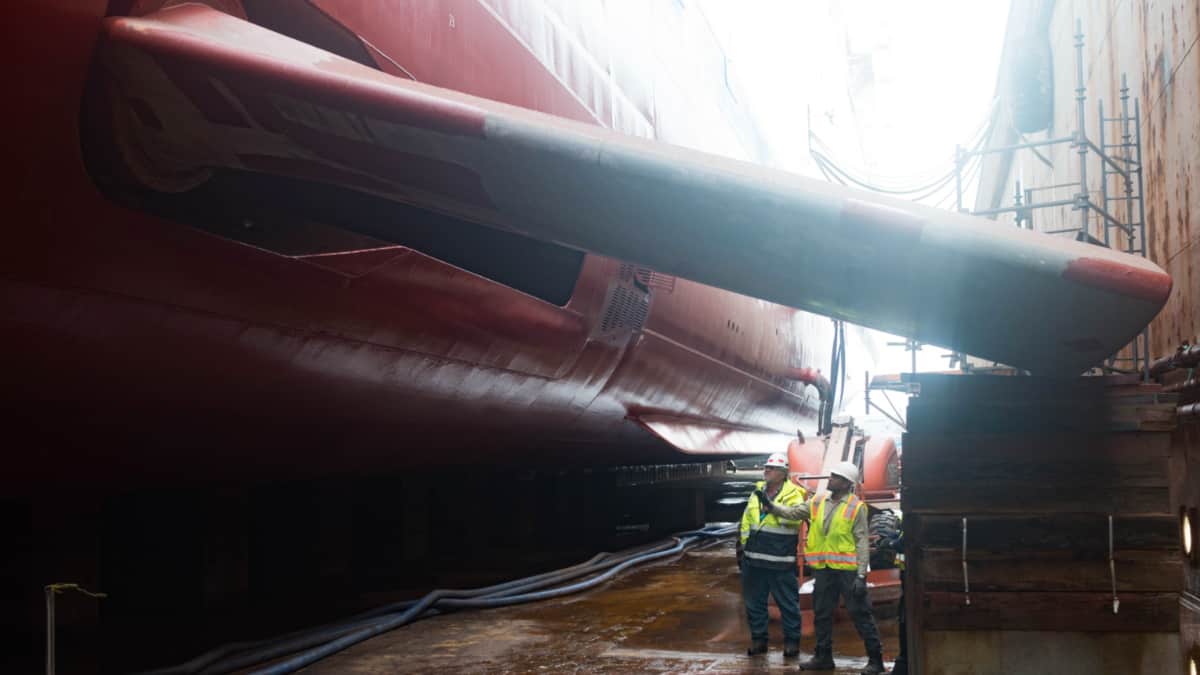Have you ever wondered how ship fin stabilizers manage to keep vessels steady amidst turbulent waters? The intricate workings of these stabilizing systems go beyond mere mechanics, offering a fascinating glimpse into the domain of maritime technology. Delving into the depths of their operation reveals a world where precision meets innovation, providing an essential understanding of how ships navigate through challenging seas.
Importance of Ship Stability
Understanding the importance of ship stability is essential for guaranteeing safe and efficient maritime operations. Ship stability refers to the vessel’s ability to maintain a state of dynamic equilibrium, where forces acting upon it, such as wind and waves, are balanced to prevent capsizing or excessive rolling.
One vital aspect of ship stability is the management of rolling resistance, which is the resistance encountered by a ship when rolling from side to side.
Proper ship stability guarantees that the vessel can navigate through various sea conditions without compromising the safety of the crew, passengers, or cargo. By minimizing rolling motions, ships can operate more smoothly, reducing the risk of seasickness among passengers and improving overall comfort onboard.
Additionally, maintaining stability aids in fuel efficiency by reducing unnecessary energy consumption due to excessive rolling. Consequently, a thorough understanding of ship stability, including the management of rolling resistance, is fundamental for the safe and efficient operation of maritime vessels.
Components of Fin Stabilizers
When considering ship stability, an essential component to examine is the fin stabilizer system.
Fin stabilizers come in various types, including retractable fins, fixed fins, and extendable fins, each offering different advantages based on the vessel’s requirements.
The installation process of fin stabilizers involves securely attaching the fins to the ship’s hull, ensuring proper alignment and structural integrity.
Here are key components of fin stabilizers:
- Fins: These are the primary components that extend from the ship’s hull to reduce roll motion.
- Actuators: These mechanisms control the movement of the fins, adjusting their position based on the vessel’s motion.
- Control System: Responsible for monitoring the ship’s movements and sending signals to the actuators to adjust the fins accordingly.
- Hydraulic System: Provides the power necessary to move the fins, ensuring quick and precise responses to stabilize the ship.
Understanding these components is vital for comprehending how fin stabilizers contribute to enhancing a ship’s stability at sea.
How Fin Stabilizers Work
To grasp how fin stabilizers work on a ship, it’s essential to explore the intricate mechanism that drives these systems. The fin design plays a vital role in the functionality of stabilizers.
Typically, fin stabilizers consist of retractable fins located below the waterline on both sides of the vessel. These fins are controlled by a hydraulic or electric system.
When the ship encounters waves or rolls due to external forces, the fin stabilizers extend outward into the water. The fluid dynamics come into play as the fins create resistance against the water flow, generating a force that counteracts the rolling motion of the ship. This action helps stabilize the vessel and reduce the uncomfortable rolling motion experienced by passengers.
The fin design is optimized to maximize the stabilizing effect while minimizing drag on the ship’s movement. By utilizing fluid dynamics principles, fin stabilizers effectively reduce the rolling motion of the ship, enhancing comfort and safety onboard.
Benefits of Using Fin Stabilizers
Utilizing fin stabilizers on a ship can greatly enhance the overall stability and comfort experienced by passengers and crew members during voyages.
These stabilizing devices offer several benefits that contribute to the performance enhancement and operational efficiency of the vessel:
- Reduced Rolling: Fin stabilizers help minimize the rolling motion of the ship caused by waves or winds, thereby providing a smoother sailing experience and reducing seasickness among passengers and crew.
- Improved Maneuverability: By reducing excessive rolling, fin stabilizers enhance the ship’s maneuverability, making it easier for the crew to navigate through challenging waters or perform docking and anchoring operations more efficiently.
- Enhanced Safety: The stability provided by fin stabilizers improves the overall safety of the vessel by reducing the risk of accidents, particularly in rough seas or adverse weather conditions.
- Increased Comfort: Passengers and crew members benefit from a more comfortable journey with reduced motion sickness and a stable platform for activities onboard, leading to a more pleasant and enjoyable voyage.
Maintenance Tips for Ship Stabilizers
The maintenance of ship stabilizers is imperative to guarantee their ideal functioning and longevity.
Regular fin inspection is essential to ascertain that the fins are free from damage or debris that could affect their performance. Begin by visually inspecting the fins for any signs of wear, cracks, or bending.
It’s vital to check the hydraulic systems that control the stabilizers for leaks, proper pressure levels, and overall functionality. Verify that the hydraulic fluid is at the correct level and that there are no visible leaks in the system.
Lubricate the moving parts of the stabilizer system as per the manufacturer’s recommendations to prevent friction and maintain smooth operation.
Additionally, check the electrical components of the stabilizer system to confirm that they’re functioning correctly.
Frequently Asked Questions
Can Fin Stabilizers Be Installed on Any Type of Ship?
Yes, fin stabilizers can generally be installed on most ship types. Considerations such as vessel size, weight distribution, and intended use play a role in determining the ideal fin stabilizer type for effective stabilization and performance enhancement.
Do Fin Stabilizers Affect the Speed of the Ship?
Yes, fin stabilizers can affect the speed of the ship. They improve fin efficiency, reducing drag, which can lead to enhanced stability and performance. Consider factors like hull design and operational conditions for ideal speed benefits.
Are There Any Safety Risks Associated With Fin Stabilizers?
Yes, there are safety risks associated with fin stabilizers. They can impact hydrodynamic efficiency, leading to potential stability issues. Additionally, maintenance challenges such as corrosion or mechanical failures can compromise the stabilizer’s effectiveness, posing safety concerns.
How Do Fin Stabilizers Perform in Rough Weather Conditions?
In rough weather conditions, fin stabilizers with advanced fin design considerably reduce ship rolling, enhancing stability and passenger comfort. The weather impact on stabilizer efficiency is minimal due to their robust construction and precise operation.
Can Fin Stabilizers Be Retrofitted on Existing Ships?
Yes, fin stabilizers can be retrofitted on existing ships. The retrofit process involves evaluating the vessel’s design compatibility, modifying the hull structure, and installing the stabilizers. Common challenges include space limitations, structural reinforcements, and integration with existing systems.






